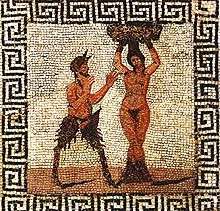Hamadryad
A hamadryad (/hæməˈdraɪ.æd/; Greek: Ἁμαδρυάδες, Hamadryádes) is a Greek mythological being that lives in trees. They are a particular type of dryad, which are a particular type of nymph. Hamadryads are born bonded to a certain tree.[1] Some believe that hamadryads are the actual tree, while normal dryads are simply the entities, or spirits, of the trees. If the tree died, the hamadryad associated with it died as well. For that reason, dryads and the gods punished any mortals who harmed trees.
List of Hamadryads
| Greek deities series |
|---|
| Nymphs |
The Deipnosophistae of Athenaeus lists eight hamadryads, the daughters of Oxylus and Hamadryas:
- Karya (walnut or hazelnut)
- Balanos (oak)
- Kraneia (dogwood)
- Morea (mulberry)
- Aigeiros (black poplar)
- Ptelea (elm)
- Ampelos (vines, especially Vitis)
- Syke (fig)
Their mother, Hamadryas, is immortalized in two scientific names: the generic name of the cracker butterfly, and the specific name of the northernmost monkey in Asia Minor, the hamadryas baboon. The cracker butterfly is more arboreal than most butterflies, as it commonly camouflages itself on trees. It feeds on sap, rotting fruit and dung. The hamadryas baboon is one of the least arboreal monkeys, but was the most common monkey in Hellenic lands.
Other hamadryads
In popular culture
Hamadryad is referenced as a whole in Edgar Allan Poe's poem, "Sonnet To Science". Hamadryad is referenced in Anthony Ashley Cooper's (The Third Earl of Shaftesbury) Characteristics of Men, Manners, Opinions, Times (1714: Treatise 4, Part 3, Section 1). In Aldous Huxley's Crome Yellow, Anne Wimbush is referred to as "the slim Hamadryad whose movements were like the swaying of a young tree in the wind". George Eliot's character, Philip Wakem, uses the term to describe Maggie Tulliver, in "The Mill on The Floss", Book V, Chapter 3. William Faulkner's character, Januarius Jones, uses this term to describe a young lady in "Soldier's Pay", Chapter 2. Both hamadryads and dryads exist in C. S. Lewis's Narnia.
See also
- Querquetulanae, Roman nymphs of the oak
